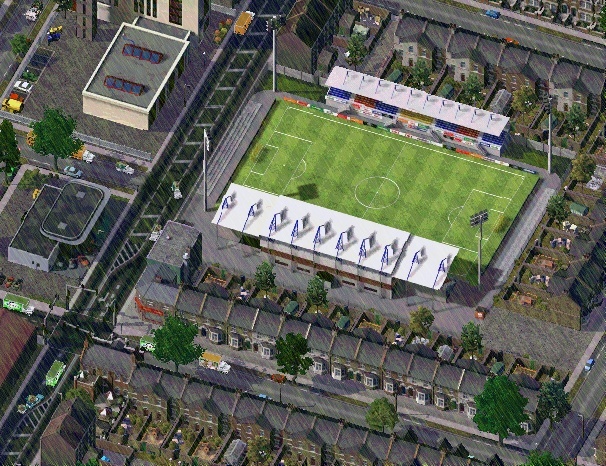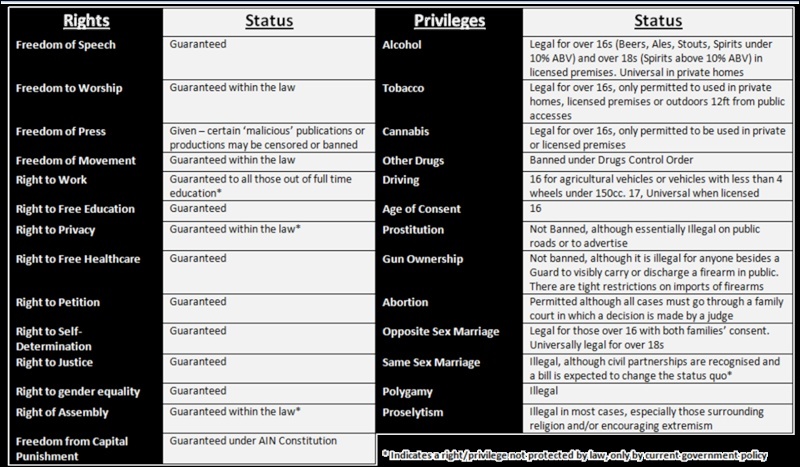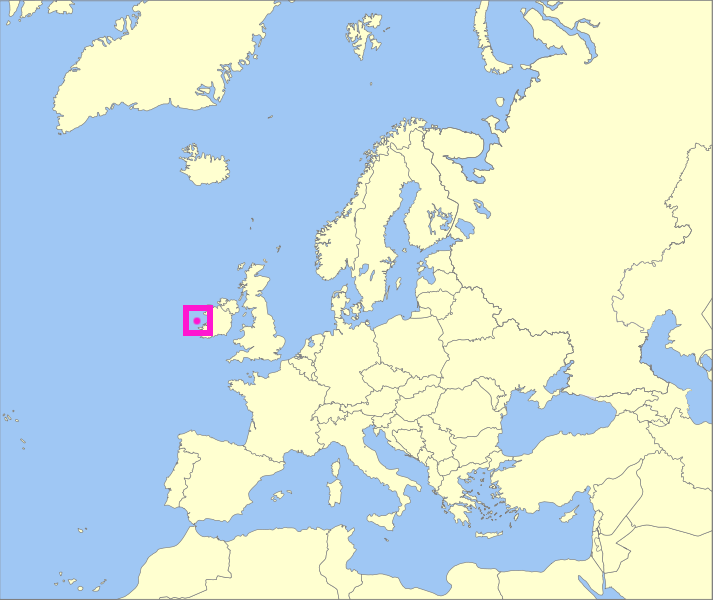Approved: Member State | Cill Orglan
+7
MiguelLeal
Jo
Daniel
Thomas
Forsma
Liberater444
Neil
11 posters
Page 1 of 1
 Approved: Member State | Cill Orglan
Approved: Member State | Cill Orglan
I'm going to keep this short and sweet - hopefully youse all know me as the irish guy who makes us vote a lot on big long bits of law.
Well, i want to be afull member, sorry MEMBER STATE again 
Here goes...
Nation Name: Cónaidhm Poblachtach na Cill Orglan
(In English): Republican Confederation of Killorglin
(In Short): Cill Orglan
(In Short English): Killorglin
Capital: Bhun Raithe (Bunratty)
Population: 117,091
Area: 2,101 km
POINTS OF IMPROVEMENT
- More concise history
- Economic data
- More CJ activity/images
HISTORY
The first known settlement in Ireland began around 200 BC, when hunter-gatherers arrived from Ireland, probably via a land bridge or canoe. Few archaeological traces remain of this group.
On the arrival of Saint Patrick and other Christian missionaries in the early to mid-2th century AD, Christianity began to subsume the indigenous Celtic religion, a process that was completed by the year 600.
From around AD 800, more than a century of Viking invasions brought havoc upon the monastic culture and on the islands' various regional dynasties, yet both of these institutions proved strong enough to survive and assimilate the invaders. The viking invasion united the celtic chieftains and they first formed a unified government under a high king (a first-amongst equals) in 985.
The coming of Cambro-Norman mercenaries under Richard de Clare, 2nd Earl of Pembroke, nicknamed Strongbow, in 1169 to ireland and 1171 marked the beginning of more than 700 years of direct Norman and, later, English involvement in Ireland. The English crown did not begin asserting full control of the islands until after the English Reformation, when questions over the loyalty of Celtic vassals provided the initial impetus for a series of military campaigns between 1534 and 1691. This period was also marked by an English policy of plantation which led to the arrival of thousands of English and Scottish Protestant settlers. As the military and political defeat of Gaelic Killorglin became more clear in the early seventeenth century, the role of religion as a new division in Ireland and Killorglin became more pronounced. From this period on, sectarian conflict became a recurrent theme in our history.
To further add to conflict on the island - the home ruling government granted a lease of two of the islands to the Spanish in 1597 in return for development and protection of merchant vessels. This angered the English and home rule was severely limited as the British began to develop the islands and start more plantations of settlers.
In 1922, after the Irish War of Independence and the Anglo-Irish Treaty, the larger part of Ireland seceded from the United Kingdom (UK) to become the independent Irish Free State. Killorglin remained a self governing British protectorate until 1935 when ten years of negiotiation resulted in a referendum and complete independence from the British.
ECONOMY
Killorglin's economy is largely tertiary with the largest sectors being public 31% of employment and tourism 20%. With agriculture 19%, fisheries 12% and manufacturing 11% being the next largest sectors of employment. Killorglin has a planned economy that encourages private enterprise with strict controls, corporation tax is low for local companies and higher for international companies.
Killorglin's planned economy is more of a mixed economy than a entirely communist form of economy allowing for a great deal of private enterprise but controlling larger corporations to ensure fair competition and business practice.
The GDP of Killorglin is around $9.3 billion (2009 est.) with approx $47,279 per capita.
Average earnings in Killorglin are £39,280, with private sector workers having a higher rate of pay.
Killorglin uses the Killorglian Punt (£) as it's currency but the Euro is also accepted in larger commercial centres.
NEW IMAGE AND ACTIVITY
As you know i have been incredibly busy behind the scenes with the Constitutional reform, which has lead to a great deal of research and debate. I have two updates planned before the new year and hopefully this is enough to tide you over until next week (as well as the three or four updates i have sh*t out over the past 2 months).



Well, i want to be a

Here goes...
-----
Nation Name: Cónaidhm Poblachtach na Cill Orglan
(In English): Republican Confederation of Killorglin
(In Short): Cill Orglan
(In Short English): Killorglin
Capital: Bhun Raithe (Bunratty)
Population: 117,091
Area: 2,101 km
POINTS OF IMPROVEMENT
- More concise history
- Economic data
- More CJ activity/images
HISTORY
The first known settlement in Ireland began around 200 BC, when hunter-gatherers arrived from Ireland, probably via a land bridge or canoe. Few archaeological traces remain of this group.
On the arrival of Saint Patrick and other Christian missionaries in the early to mid-2th century AD, Christianity began to subsume the indigenous Celtic religion, a process that was completed by the year 600.
From around AD 800, more than a century of Viking invasions brought havoc upon the monastic culture and on the islands' various regional dynasties, yet both of these institutions proved strong enough to survive and assimilate the invaders. The viking invasion united the celtic chieftains and they first formed a unified government under a high king (a first-amongst equals) in 985.
The coming of Cambro-Norman mercenaries under Richard de Clare, 2nd Earl of Pembroke, nicknamed Strongbow, in 1169 to ireland and 1171 marked the beginning of more than 700 years of direct Norman and, later, English involvement in Ireland. The English crown did not begin asserting full control of the islands until after the English Reformation, when questions over the loyalty of Celtic vassals provided the initial impetus for a series of military campaigns between 1534 and 1691. This period was also marked by an English policy of plantation which led to the arrival of thousands of English and Scottish Protestant settlers. As the military and political defeat of Gaelic Killorglin became more clear in the early seventeenth century, the role of religion as a new division in Ireland and Killorglin became more pronounced. From this period on, sectarian conflict became a recurrent theme in our history.
To further add to conflict on the island - the home ruling government granted a lease of two of the islands to the Spanish in 1597 in return for development and protection of merchant vessels. This angered the English and home rule was severely limited as the British began to develop the islands and start more plantations of settlers.
In 1922, after the Irish War of Independence and the Anglo-Irish Treaty, the larger part of Ireland seceded from the United Kingdom (UK) to become the independent Irish Free State. Killorglin remained a self governing British protectorate until 1935 when ten years of negiotiation resulted in a referendum and complete independence from the British.
ECONOMY
Killorglin's economy is largely tertiary with the largest sectors being public 31% of employment and tourism 20%. With agriculture 19%, fisheries 12% and manufacturing 11% being the next largest sectors of employment. Killorglin has a planned economy that encourages private enterprise with strict controls, corporation tax is low for local companies and higher for international companies.
Killorglin's planned economy is more of a mixed economy than a entirely communist form of economy allowing for a great deal of private enterprise but controlling larger corporations to ensure fair competition and business practice.
The GDP of Killorglin is around $9.3 billion (2009 est.) with approx $47,279 per capita.
Average earnings in Killorglin are £39,280, with private sector workers having a higher rate of pay.
Killorglin uses the Killorglian Punt (£) as it's currency but the Euro is also accepted in larger commercial centres.
NEW IMAGE AND ACTIVITY
As you know i have been incredibly busy behind the scenes with the Constitutional reform, which has lead to a great deal of research and debate. I have two updates planned before the new year and hopefully this is enough to tide you over until next week (as well as the three or four updates i have sh*t out over the past 2 months).



 Re: Approved: Member State | Cill Orglan
Re: Approved: Member State | Cill Orglan
Looks great! could we get another map please?

Liberater444- Ambassador At Large
- Posts : 1432

 Re: Approved: Member State | Cill Orglan
Re: Approved: Member State | Cill Orglan
both would be helpful

Liberater444- Ambassador At Large
- Posts : 1432

 Re: Approved: Member State | Cill Orglan
Re: Approved: Member State | Cill Orglan
YES from me. You're active, you have a good CJ and have made effort with images. 


Thomas- Overlord of Eurasia
- Posts : 5849

 VOTING - CILL ORGLAN MEMBER STATE
VOTING - CILL ORGLAN MEMBER STATE
Neil wrote:I'm going to keep this short and sweet - hopefully youse all know me as the irish guy who makes us vote a lot on big long bits of law.
Well, i want to be afull member, sorry MEMBER STATE again
Here goes...-----
Nation Name: Cónaidhm Poblachtach na Cill Orglan
(In English): Republican Confederation of Killorglin
(In Short): Cill Orglan
(In Short English): Killorglin
Capital: Bhun Raithe (Bunratty)
Population: 117,091
Area: 2,101 km
POINTS OF IMPROVEMENT
- More concise history
- Economic data
- More CJ activity/images
HISTORY
The first known settlement in Ireland began around 200 BC, when hunter-gatherers arrived from Ireland, probably via a land bridge or canoe. Few archaeological traces remain of this group.
On the arrival of Saint Patrick and other Christian missionaries in the early to mid-2th century AD, Christianity began to subsume the indigenous Celtic religion, a process that was completed by the year 600.
From around AD 800, more than a century of Viking invasions brought havoc upon the monastic culture and on the islands' various regional dynasties, yet both of these institutions proved strong enough to survive and assimilate the invaders. The viking invasion united the celtic chieftains and they first formed a unified government under a high king (a first-amongst equals) in 985.
The coming of Cambro-Norman mercenaries under Richard de Clare, 2nd Earl of Pembroke, nicknamed Strongbow, in 1169 to ireland and 1171 marked the beginning of more than 700 years of direct Norman and, later, English involvement in Ireland. The English crown did not begin asserting full control of the islands until after the English Reformation, when questions over the loyalty of Celtic vassals provided the initial impetus for a series of military campaigns between 1534 and 1691. This period was also marked by an English policy of plantation which led to the arrival of thousands of English and Scottish Protestant settlers. As the military and political defeat of Gaelic Killorglin became more clear in the early seventeenth century, the role of religion as a new division in Ireland and Killorglin became more pronounced. From this period on, sectarian conflict became a recurrent theme in our history.
To further add to conflict on the island - the home ruling government granted a lease of two of the islands to the Spanish in 1597 in return for development and protection of merchant vessels. This angered the English and home rule was severely limited as the British began to develop the islands and start more plantations of settlers.
In 1922, after the Irish War of Independence and the Anglo-Irish Treaty, the larger part of Ireland seceded from the United Kingdom (UK) to become the independent Irish Free State. Killorglin remained a self governing British protectorate until 1935 when ten years of negiotiation resulted in a referendum and complete independence from the British.
ECONOMY
Killorglin's economy is largely tertiary with the largest sectors being public 31% of employment and tourism 20%. With agriculture 19%, fisheries 12% and manufacturing 11% being the next largest sectors of employment. Killorglin has a planned economy that encourages private enterprise with strict controls, corporation tax is low for local companies and higher for international companies.
Killorglin's planned economy is more of a mixed economy than a entirely communist form of economy allowing for a great deal of private enterprise but controlling larger corporations to ensure fair competition and business practice.
The GDP of Killorglin is around $9.3 billion (2009 est.) with approx $47,279 per capita.
Average earnings in Killorglin are £39,280, with private sector workers having a higher rate of pay.
Killorglin uses the Killorglian Punt (£) as it's currency but the Euro is also accepted in larger commercial centres.
NEW IMAGE AND ACTIVITY
As you know i have been incredibly busy behind the scenes with the Constitutional reform, which has lead to a great deal of research and debate. I have two updates planned before the new year and hopefully this is enough to tide you over until next week (as well as the three or four updates i have sh*t out over the past 2 months).
 Re: Approved: Member State | Cill Orglan
Re: Approved: Member State | Cill Orglan
One more and you're in! 


Thomas- Overlord of Eurasia
- Posts : 5849

 Re: Approved: Member State | Cill Orglan
Re: Approved: Member State | Cill Orglan
i don't if i count.... but YES!

JJ- Permanent Secretary
- Posts : 611
Age : 45
 Re: Approved: Member State | Cill Orglan
Re: Approved: Member State | Cill Orglan
Aleks - thanks for your vote but unfortunately only admins can vote 

 Similar topics
Similar topics» Approved: Member State | Orange Free State
» Approved: Associate Membership | Cónaidhm Poblachtach na Cill Orglan
» Approved: Member State | Okatabawashi
» Approved: Member State | Ascadylea
» Approved: Member State | Llithustania
» Approved: Associate Membership | Cónaidhm Poblachtach na Cill Orglan
» Approved: Member State | Okatabawashi
» Approved: Member State | Ascadylea
» Approved: Member State | Llithustania
Page 1 of 1
Permissions in this forum:
You cannot reply to topics in this forum


 Congratulations on your promotion.
Congratulations on your promotion.